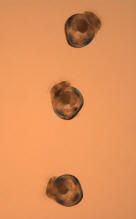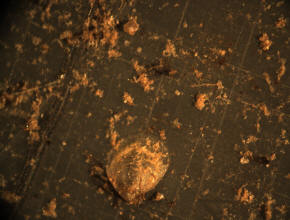




My research involved observing settlement patterns of the native West Coast oyster, Ostrea conchaphila (formerly Ostrea lurida), within two estuaries in southern California, Upper Newport Bay in Newport, and Aqua Hedionda Lagoon in Carlsbad. This species was heavily harvested and exposed to high levels of pollution in the early 1900s. There has been recent interest in restoring its populations. Since local population persistence is influenced by larval settlement, information about the magnitude and timing of settlement will provide valuable contributions to restoration efforts. So, I examined settlement as a function of season and simultaneously measured temperature, which is reported to influence settlement timing by cueing synchronized male spawning and subsequent larval settlement.
To observe variation over seasons in larval settlement density, I placed replicate tiles in two separate locations within Newport Bay, CA and in two locations within Aqua Hedionda Lagoon, Carlsbad, CA. Temperature was monitored at each site every 15 minutes using Tidbit™ loggers. Tiles were collected and oyster settlers counted every two weeks during spring tides to pinpoint pulses in settlement.
My results showed greatest settlement in June-August, and minimal to no settlement in other months. Settlement was also significantly higher at the Newport sites than the Carlsbad site, but only when pulses in settlement occurred during the June peak.
I am currently a NOAA intern working at the Hatfield Marine Station in Newport, OR where I study larval fish vertical migration behavior. I plan to apply for graduate school in fall 2007.
Seasonal settlement of oyster larvae in two Southern California Estuaries
|
|
|
|||||||||||
 |
 |
|
||||||||||
|
|
 |
|
||||||||||
|
|
|
|||||||||||
|
|
|
|
|
|||||||||
|
|
|
|||||||||||
|
|
|
|
|
|||||||||
|
|
|
|||||||||||
|
|
|
|
|
|||||||||
|
|
|
|||||||||||
|
|
|
|
|
|||||||||
|
|
|
|||||||||||
|
|
|
|
|
|||||||||
 |
|
|||||||||||
 |
|
|||||||||||
 |
|
|||||||||||
|
|
|
|
|
|
|
|
|
|
|
|
|
|